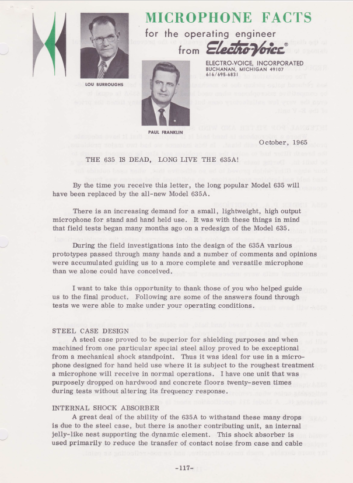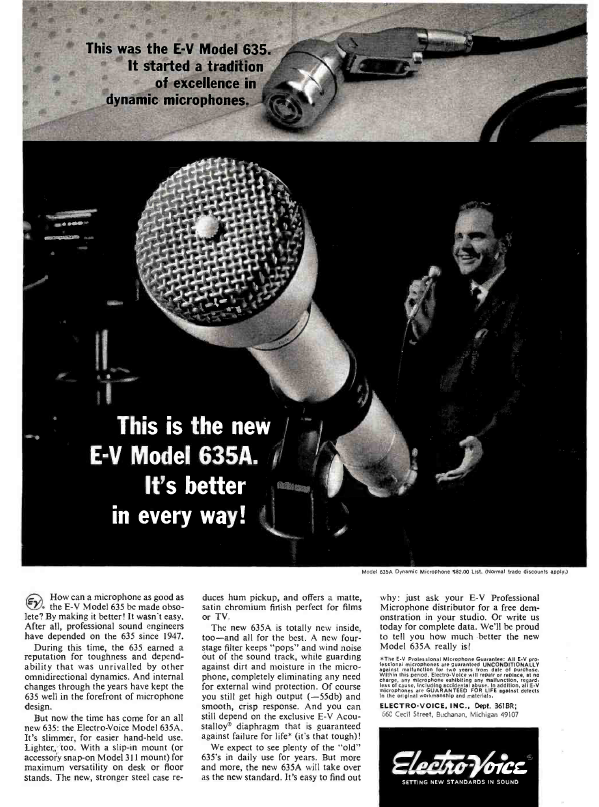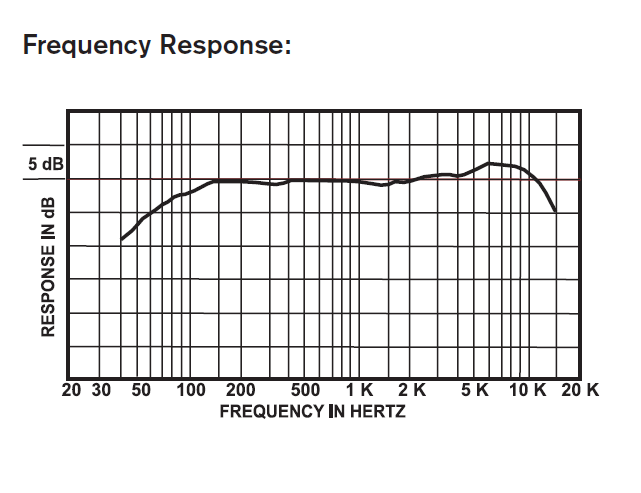
No TV station today would send a crew to a news conference with a 16 mm film camera. Today’s radio reporter would think you were crazy if issued a reel-to-reel recorder before heading out on a story.
Audio and video have seen multiple generations of improvements leading to today’s digital gear. But for many radio and TV crews, one basic item has turned 55 years old and does not appear to be getting replaced.
In October 1965, Electro-Voice Vice President of Broadcast and Recording Equipment Lou Burroughs proclaimed, “The 635 is dead, long live the 635A!”
In a newsletter to customers, Burroughs wrote, “There is increasing demand for a small, lightweight, high-output microphone for stand and handheld use.” Click the image below to read the letter.

In a Broadcasting magazine full-page ad, Electro-Voice mentioned that the original 635 had been in use since 1947. The 635 was designed to be used on a stand: the cable connector was adjacent to threaded stand mount attached to the microphone through a hinge. It was unwieldy as a stick mic. The ad copy for the 635A included what at the time was a marketing boast, “the new 635A will take over as the new standard.” (Click the image to read the ad.)

It turned out to be a prescient line. With so little 1965 technology still in use, the endurance of the 635A is remarkable. Electro-Voice’s Guy Low attributes the longevity of “our most iconic product” in part to its utilitarian, workhorse role.
Burroughs noted what is likely the key to the 635A’s success. “I have one unit that was purposely dropped on hardwood and concrete floors 27 times during tests without altering its frequency response.”
One major market chief photographer referred to the 635A as a “hammer” for its resilience. There are 635As of uncertain vintage lurking in many an audio box, scuffed and perhaps with a dented screen, but still sounding as good as new.
While the 635A does not make as many appearances on entertainment TV as it used to, its presence is a unifying element for news conferences over the last six decades.
In 1967, Stanford University scientists announced a breakthrough in genetic research. At least three 635As were used to capture the sound of the event.
Electro-Voice management has not considered withdrawing the 635A from its catalog, as demand for the original model continues year after year.
“There isn’t necessarily a need for any bells and whistles to be added,” to the 635A, Low said. The original 635A model came in Electro-Voice’s standard fawn beige color and was 6 inches long. Over time, the company added a black color option, the 635L, which is 3.5 inches longer than the original, and the 635N/D-B, which uses Electro-Voice’s neodymium element.

Electro-Voice’s Low adds the 635A is attracting a new generation of fans, “We are hearing from kids who are using these mics on stage and studio … and people like them because they are robust and durable and they kind of hearken back to the era when things were built to last.”
Electro-Voice aficionados were a bit concerned in 2006, when the company became part of the German conglomerate Bosch. The American name for microphones, speakers and other audio products was now part of an organization that made RTS intercoms but had many interests, including the aviation, automobile, and security sectors.
Low said little has changed as the parent firm, “lets each brand’s core competencies remain in place.”
Those same technical developments that have affected broadcasting have led to podcasting and home studios. Low added the company’s standard studio microphone, the RE20, is seeing record sales numbers, likely due to demand from podcasters trying to recreate the sound of radio stations, “people imitate what they see.”
Electro-Voice has no official records of how many 635A microphones have been sold in the unit’s 55-year history. But even if Electro-Voice were to discontinue its manufacture, its resiliency and the many thousands likely sold would keep the 635A in use for a long time to come.
Kevin Curran, Ph.D., is a veteran broadcast journalist and member of the journalism faculty at Loyola Marymount University in Los Angeles.







